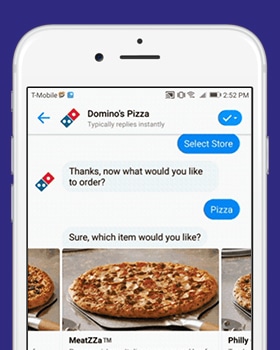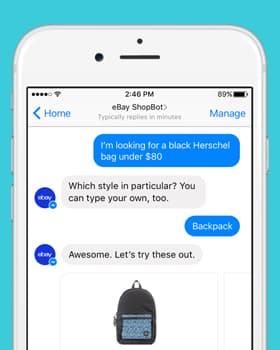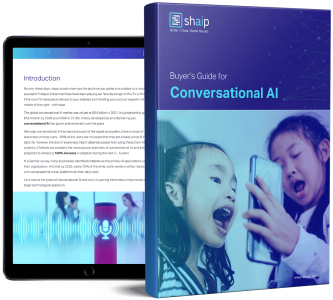The Complete Guide to Conversational AI
The Ultimate Buyers Guide 2024
Introduction
No one these days stops to ask when the last time you spoke to a chatbot or a virtual assistant was? Instead, machines have been playing our favorite song, quickly identifying a local Chinese place that delivers to your address and handles requests in the middle of the night – with ease.

Who is this Guide for?
This extensive guide is for:
- All entrepreneurs and solopreneurs who are crunching on massive amounts of data
- AI/ML or professionals who are getting started with process optimization techniques
- Project managers who intend to implement a quicker time-to-market for their AI models or AI-driven products
- And tech enthusiasts who like to get into the details of the layers involved in AI processes.

What is Conversational AI
Conversational AI is an advanced form of artificial intelligence that enables machines to engage in interactive, human-like dialogues with users. This technology understands and interprets human language to simulate natural conversations. It can learn from interactions over time to respond contextually.
Conversational AI systems are widely used in applications such as chatbots, voice assistants, and customer support platforms across digital and telecommunication channels. Here are some key statistics to illustrate its impact:
- The global conversational AI market was valued at $6.8 billion in 2021 and is projected to grow to $18.4 billion by 2026 at a CAGR of 22.6%. By 2028, the market size is expected to reach $29.8 billion.
- Despite its prevalence, 63% of users are unaware that they use AI in their daily lives.
- A Gartner survey found that many businesses identified chatbots as their primary AI application, with nearly 70% of white-collar workers expected to interact with conversational platforms daily by 2022.
- Since the pandemic, the volume of interactions handled by conversational agents has increased by as much as 250% across multiple industries.
- In 2022, 91% of adult voice assistant users used conversational AI technology on their smartphones.
- Browsing and searching for products were the top shopping activities conducted using voice assistant technology among US users in a 2021 survey.
- Among tech professionals worldwide, nearly 80% use virtual assistants for customer service.
- By 2024, 73% of North American customer service decision-makers believe online chat, video chat, chatbots, or social media will be the most-used customer service channels.
- As of February 2022, 53% of US adults had communicated with an AI chatbot for customer service in the last year.
- In 2022, 3.5 billion chatbot apps were accessed worldwide.
- The top three reasons US consumers use a chatbot are for business hours (18%), product information (17%), and customer service requests (16%).
These statistics highlight the increasing adoption and influence of conversational AI across various industries and consumer behaviors.
How does Conversational AI work
Conversational AI uses natural language processing (NLP) and other sophisticated algorithms to engage in context-rich dialogues. As the AI encounters a broader range of user inputs, it improves its pattern recognition and predictive abilities. The process of conversational AI engaging with users can be broken down into four key steps.
Conversational AI begins with input collection, where users provide their input through text or voice. For text input, natural language understanding (NLU) is used to extract meaning, while voice input is first converted to text using automatic speech recognition (ASR). The system then generates a response using natural language generation techniques. Over time, conversational AI continuously improves by analyzing user interactions, refining its responses to ensure they are accurate and relevant.
Conversational AI is like chatting with a super-smart computer that gets what you’re saying and talks back like a real person. Here’s how it works in a simple way:
- Understanding What You Say: Whether you’re talking or typing, the AI listens carefully. It breaks down your words to figure out what you mean, even picking up on your tone or emotions.
- Making Sense of It: After understanding your words, the AI tries to understand the bigger picture. It looks for patterns and context to grasp what you’re really asking or saying.
- Responding to You: Once it gets what you mean, the AI quickly thinks of the best response. It might ask more questions or give you the info you need, all while sounding natural and friendly.
- Sounding Like a Human: The AI works hard to make the conversation feel smooth, like you’re talking to a person, not a machine.
- Getting Smarter Over Time: The more you chat with it, the better it gets. It learns from every interaction, improving its understanding of different accents, languages, and even slang.
- Handling Voice and Keeping Track: If you talk instead of type, the AI uses speech recognition to turn your voice into text. It also remembers what you’ve said earlier to keep the conversation on track.
- Always Improving: Over time, the AI refines its responses, getting more accurate and helpful with every conversation.
Types of Conversational AI
Conversational AI can greatly benefit businesses by addressing different needs and providing tailored solutions. There are three main types of conversational AI: chatbots, voice assistants, and interactive voice responses. Choosing the right model depends on your business goals and use case.
Chatbots
Chatbots are text-based AI tools that engage users via messaging or websites. They can be rule-based, AI/NLP-driven, or hybrid. Chatbots automate customer support, sales, and lead generation tasks while offering personalized assistance.
Voice Assistants
Voice assistants (VA) or Voice bots enable interaction through voice commands. They process spoken language for hands-free engagement & are found in smart phones & speakers. VA's assist in customer support, appointment scheduling, directions, & FAQs.
IVR
IVRs are rule-based telephony systems that allow interaction via voice commands or touch-tone inputs. They automate call routing, information gathering, & self-service options. IVRs efficiently handle high call volumes in customer & sales.
Difference between AI & Rule-Based Chatbot
| Feature | Traditional / Rule-Based Chatbot | AI/NLP Chatbot (Conversational AI) |
|---|---|---|
| Natural Language Processing (NLP) Capability | Relies on rule-based systems with predefined responses, limiting understanding of complex queries. | Uses advanced NLP to understand and interpret natural language, providing smarter, context-aware responses. |
| Contextual Understanding | Often struggles with maintaining conversation context and remembering past interactions. | Tracks conversation history and user preferences for personalized and coherent interactions. |
| Machine Learning and Self-Learning | Operates on predefined scripts and needs manual updates to improve. | Employs machine learning to continuously learn from interactions and improve automatically. |
| Multichannel, Omnichannel, & Multimodal Capabilities | Generally limited to specific platforms like websites or messaging apps and is text-based. | Functions across multiple channels, including voice assistants, mobile apps, and social media, with text and voice capabilities. |
| Interaction Mode | Understands and interacts with text commands only. | Understands and interacts with both voice and text commands. |
| Context and Intent Understanding | Can follow predetermined chat flow it has been trained on. | Can understand context and interpret intent in conversations. |
| Dialogue Style | Designed to be purely navigational. | Designed to have conversational dialogues. |
| Interfaces | Works as a chat support interface only. | Works on multiple interfaces such as blogs and virtual assistants. |
| Learning and Updates | Follows a predesigned set of rules and has to be configured with new updates. | Can learn from interactions and conversations. |
| Training Requirements | Faster and less expensive to train. | Requires significant time, data, and resources to train. |
| Response Customization | Carries out predictable tasks. | Can provide customized responses based on interactions. |
| Use Case | Ideal for more straightforward and well-defined use cases. | Ideal for complex projects that need advanced decision-making. |
Benefits of Conversational AI
Conversational AI has become increasingly advanced, intuitive, and cost-effective, leading to widespread adoption across industries. Let’s explore the significant benefits of this innovative technology in more detail:
Personalized Conversations Across Multiple Channels
Conversational AI enables organizations to deliver top-class customer service through personalized interactions across various channels, providing a seamless customer journey from social media to live web chats.
Effortlessly Scale to Manage High Call Volumes
Conversational AI can help customer service teams handle sudden spikes in call volume by categorizing interactions based on customer intent, requirements, call history, and sentiment. This enables efficient routing of calls, ensuring live agents handle high-value interactions while chatbots manage low-value ones.
Elevate Customer Service
The customer experience has become a significant brand differentiator. Conversational AI helps businesses deliver positive experiences. It provides instant, accurate responses to queries and develops customer-centric responses using speech recognition technology, sentiment analysis, and intent recognition.
Supports Marketing and Sales Initiatives
Conversational AI allows businesses to create unique brand identities and gain a competitive edge in the market. Businesses can integrate AI chatbots into the marketing mix to develop comprehensive buyer profiles, understand buying preferences, and design personalized content tailored to customers’ needs.
Better Cost Savings With Automated Customer Care
Chatbots provide cost-efficiency, with predictions that they will save businesses $8 billion annually by 2022. Developing chatbots to handle simple and complex queries reduces the need for continuous training for customer service agents. While initial implementation costs may be high, the long-term benefits outweigh the initial investment.
Multilingual Support for Global Reach
Conversational AI can be programmed to support multiple languages, enabling businesses to cater to a global customer base. This ability helps companies provide seamless support to non-English speaking customers, breaking language barriers and improving overall customer satisfaction.
Improved Data Collection and Analysis
Conversational AI platforms can collect and analyze vast amounts of customer data, offering invaluable insights into customer behavior, preferences, and concerns. This data-driven approach helps businesses make informed decisions, refine marketing strategies, and develop better products and services. Furthermore, this continuous data flow enhances the AI’s learning capability, leading to more accurate and efficient responses over time.
24/7 Availability
Conversational AI can provide round-the-clock support, ensuring that customers receive assistance whenever needed, regardless of time zones or public holidays. This continuous availability is particularly important for businesses with global operations or customers requiring support outside traditional business hours.
Example of Conversational AI
Many large and small companies use AI-driven chatbots and virtual helpers on social media. These tools help businesses interact with customers, answer questions, and provide support quickly and easily. Here are some examples:



Dominos – Order, queries, status chatbot
Domino’s chatbot, “Dom,” is available on multiple platforms, including Facebook Messenger, Twitter, and the company’s website.
Dom enables customers to place orders, track deliveries, and receive custom pizza recommendations based on their preferences. This AI-driven approach has enhanced the overall customer experience and made the ordering process more efficient.
Spotify – Music finding chatbot
Spotify’s chatbot on Facebook Messenger helps users find, listen to, and share music. The chatbot can recommend playlists based on user preferences, mood, or activities and even provide customized playlists upon request.
The AI-driven chatbot lets users discover new music and share their favorite tracks directly through the Messenger app, enhancing the overall music experience.
eBay – Intuitive ShopBot
eBay’s ShopBot, available on Facebook Messenger, assists users in finding products and deals on eBay’s platform. The chatbot can provide personalized shopping suggestions based on user preferences, price ranges, and interests.
Users can also upload a photo of an item they’re looking for, and the chatbot will use image recognition technology to find similar items on eBay. This AI-powered solution streamlines shopping and helps users discover unique items and bargains.
Text-to-Speech (TTS) Software
- Audiobooks: Turning written books into audio for those who love to listen. Companies: Amazon (Audible), Google Play Books
- GPS Directions: Helping drivers with spoken turn-by-turn instructions. Companies: Google Maps, Waze, Apple Maps
- Assistive Tech: Giving a voice to text for people with visual impairments. Companies: JAWS, NVDA, Microsoft Narrator
- Online Learning: Converting lessons into audio so you can learn on the go. Companies: Coursera, Udemy (integrating TTS for course content)
- Voice Assistants: Powering the voices behind Alexa, Siri, and Google Assistant. Companies: Amazon, Apple, Google
Speech Recognition Software
- Lecture Notes: Automatically turning spoken lectures into written notes. Companies: Otter.ai, Microsoft OneNote, Rev
- Medical Records: Doctors using voice to quickly document patient info. Companies: Nuance (Dragon Medical), M*Modal
- Customer Calls: Transcribing phone calls for better service and training. Companies: IBM Watson, Google Cloud Speech-to-Text, Verint
- Captions: Creating real-time captions for videos and live broadcasts. Companies: Google Live Caption, YouTube, Zoom
- Smart Homes: Letting you control your home with simple voice commands. Companies: Amazon (Alexa), Google (Assistant), Apple (HomeKit)
Mitigate Common Data Challenges in Conversational AI
Conversational AI is dynamically transforming human-computer communication. And many businesses are keen on developing advanced conversational AI tools and applications that can alter how business is done. However, before developing a chatbot that can facilitate better communication between you and your customers, you must look at the many developmental pitfalls you might face.
Language Diversity

In 2022, about 1.5 billion people spoke English worldwide, followed by Chinese Mandarin with 1.1 billion speakers. Although English is the most spoken and studied foreign language globally, only about 20% of the world population speaks it. It makes the rest of the global population – 80% – speak languages other than English. So, when developing a chatbot, you must also consider language diversity.
Language Variability
Human beings speak different languages and the same language differently. Unfortunately, it is still impossible for a machine to fully comprehend spoken language variability, factoring in the emotions, dialects, pronunciation, accents, and nuances.
Our words and language choice are also reflected in how we type. A machine can be expected to understand and appreciate the variability of language only when a group of annotators trains it on various speech datasets.
Dynamism in Speech
Another major challenge in developing a conversational AI is bringing speech dynamism into the fray. For example, we use several fillers, pauses, sentence fragments, and undecipherable sounds when talking. In addition, speech is much more complex than the written word since we don’t usually pause between every word and stress on the right syllable.
When we listen to others, we tend to derive the intent and meaning of their conversation using our lifetime of experiences. As a result, we contextualize and comprehend their words even when it is ambiguous. However, a machine is incapable of this quality.
Noisy Data
Noisy data or background noise is data that doesn’t provide value to the conversations, such as doorbells, dogs, kids, and other background sounds. Therefore, it is essential to scrub or filter the audio files of these sounds and train the AI system to identify the sounds that matter and those that don’t.
Pros & Cons of different Speech Data Types

In case you are looking for a generic dataset type, you have plenty of public speech options available. However, for something more specific and relevant to your project requirement, you might have to collect and customize it on your own.
1. Proprietary Speech Data
The first place to look would be your company’s proprietary data. However, since you have the legal right and consent to use your customer speech data, you could be able to use this massive dataset for training and testing your projects.
Pros:
- No additional training data collection costs
- The training data is likely relevant to your business
- Speech data also has natural environmental background acoustics, dynamic users, and devices.
Cons:
- Using such data might cost you a ton of money on permission to record and use.
- The speech data could have language, demographic, or customer base limitations
- Data might be free, but you’ll still pay for the processing, transcription, tagging, and more.
2. Public Datasets
Public speech datasets are another option if you don’t intend to use yours. These datasets are a part of the public domain and could be gathered for open-source projects.
Pros:
- Public datasets are free and ideal for low-budget projects
- They are available for immediate download
- Public datasets come in a variety of scripted and unscripted sample sets.
Cons:
- The processing and quality assurance costs could be high
- The quality of public speech datasets vary to a significant degree
- The speech samples offered are usually generic, making them unsuitable for developing specific speech projects
- The datasets are typically biased towards the English language
3. Pre-Packaged/Off-the-shelf Datasets
Explore pre-packaged datasets is another option if public data or proprietary speech data collection doesn’t suit your needs. The vendor has collected pre-packaged speech datasets for the specific purpose of reselling to clients. This type of dataset could be used to develop generic applications or specific purposes.
Pros:
- You might get access to a dataset that suits your specific speech data need
- It is more affordable to use a pre-packaged dataset than to collect your own
- You might be able to get access to the dataset quickly
Cons:
- Since the dataset is pre-packaged, it is not customized to your project needs.
- Moreover, the dataset is not unique to your company as any other business can purchase it.
4. Choose Custom Collected Datasets
When building a speech application, you would require a training dataset that meets all your specific requirements. However, it is highly unlikely that you get access to a pre-packaged dataset that caters to the unique requirements of your project. The only option available would be to create your dataset or procure the dataset through third-party solution providers.
The datasets for your training and testing needs are completely customizable. You can include language dynamism, speech data variety, and access to various participants. In addition, the dataset can be scaled to meet your project demands on time.
Pros:
- Datasets are collected for your specific use case. The chance of AI algorithms deviating from the intended outcomes is minimized.
- Control and reduce bias in AI Data
Cons:
- The datasets can be costly and time consuming; however the benefits always outweigh the costs.

Conversational AI Use Cases
The world of possibilities for speech data recognition and voice applications is immense, and they are being used in several industries for a plethora of applications.
Smart Home Appliances/devices
In the Voice Consumer Index 2021, it was reported that close to 66% of users from the US, UK, and Germany interacted with smart speakers, and 31% used some form of voice tech every day. In addition, smart devices such as televisions, lights, security systems, and others respond to voice commands thanks to voice recognition technology.
Voice Search Application
Voice search is one of the most common applications of conversational AI development. About 20% of all searches conducted on Google come from its voice assistant technology. 74% of respondents to a survey said that they used voice search in the last month.
Consumers increasingly rely on voice search for their shopping, customer support, locating businesses or addresses, and conducting inquiries.
Customer Support
Customer support is one of the most prominent use cases of speech recognition technology as it helps improve the customer shopping experience affordably and effectively.
Healthcare
Latest developments in conversational AI products are seeing a significant benefit for healthcare. It is being used extensively by doctors and other medical professionals to capture voice notes, improve diagnosis, provide consultation and maintain patient-doctor communication.
Security Applications
Voice recognition is seeing another use case in the form of security applications where the software determines the unique voice characteristics of individuals. It allows entry or access to applications or premises based on the voice match. Voice biometrics eliminates identity theft, credential duplication, and data misuse.
Vehicular Voice Commands
Vehicles, mostly cars, have voice recognition software that responds to voice commands that enhance vehicular safety. These conversational AI tools accept simple commands such as adjusting the volume, making calls, and selecting radio stations.
Industries Using Conversational AI
Currently, conversational AI is predominantly being used as Chatbots. However, several industries are implementing this technology to garner huge benefits. Some of the industries using conversational AI are:
Healthcare

- Patient engagement in post-treatment phase
- Appointment scheduling chatbots
- Answering faq’s and general inquiries
- Symptom assessment
- Identify critical care patients
- Escalation of emergency cases
Ecommerce

- Gathering customer information
- Provide relevant product information and recommendations
- Improving customer satisfaction
- Helping place orders and returns
- Answer FAQs
- Cross-sell and upsell products
Banking

- Real-time balance check
- Help with deposits
- Assist in filing taxes and applying for loans
- Streamline the banking process by sending bill reminders, notifications, and alerts
Insurance

- Provide policy recommendations
- Faster claim settlements
- Eliminate wait times
- Gather customer feedback & reviews
- Create customer awareness about policies
- Manage faster claims and renewal

Shaip Offering
When it comes to providing quality and reliable datasets for developing advanced human-machine interaction speech applications, Shaip has been leading the market with its successful deployments. However, with an acute shortage of chatbots and speech assistants, companies are increasingly seeking the services of Shaip – the market leader – to provide customized, accurate, and quality datasets for training and testing for AI projects.
By combining natural language processing, we can provide personalized experiences by helping develop accurate speech applications that mimic human conversations effectively. We use a slew of high-end technologies to deliver high-quality customer experiences. NLP teaches machines to interpret human languages and interact with humans.

Audio Transcription
Shaip is a leading audio transcription service provider offering a variety of speech/audio files for all types of projects. In addition, Shaip offers a 100% human-generated transcription service to convert Audio and Video files – Interviews, Seminars, Lectures, Podcasts, etc. into easily readable text.
Speech Labeling
Shaip offers extensive speech labeling services by expertly separating the sounds and speech in an audio file and labeling each file. By accurately separating similar audio sounds and annotating them,
Speaker Diarization
Sharp’s expertise extends to offering excellent speaker diarization solutions by segmenting the audio recording based on their source. Furthermore, the speaker boundaries are accurately identified and classified, such as speaker 1, speaker 2, music, background noise, vehicular sounds, silence, and more, to determine the number of speakers.
Audio Classification
Annotation begins with classifying audio files into predetermined categories. The categories depend primarily on the project’s requirements, and they typically include user intent, language, semantic segmentation, background noise, the total number of speakers, and more.
Natural Language Utterance Collection/ Wake-up Words
It is difficult to predict that the client will always choose similar words when asking a question or initiating a request. E.g., “Where is the closest Restaurant?” “Find Restaurants near me” or “Is there a restaurant nearby?”
All three utterances have the same intent but are phrased differently. Through permutation and combination, the expert conversational ai specialists at Shaip will identify all the possible combinations possible to articulate the same request. Shaip collects and annotates utterances and wake-up words, focusing on semantics, context, tone, diction, timing, stress, and dialects.
Multilingual Audio Data Services
Multilingual audio data services are another highly preferred offering from Shaip, as we have a team of data collectors collecting audio data in over 150 languages and dialects across the globe.
Intent Detection
Human interactions and communications are often more complicated than we give them credit for. And this innate complication makes it tough to train an ML model to understand human speech accurately.
Moreover, different people from the same demographic or different demographic groups can express the same intent or sentiment differently. So, the speech recognition system must be trained to recognize common intent regardless of the demographic.
Intent Classification
Similar to identifying the same intent from different people, your chatbots should also be trained to categorize customer comments into various categories – pre-determined by you. Every chatbot or virtual assistant is designed and developed with a specific purpose. Shaip can classify user intent into predefined categories as required.
Automatic Speech Recognition (ASR)
Speech Recognition” refers to converting spoken words into the text; however, voice recognition & speaker identification aims to identify both spoken content and the speaker’s identity. ASR’s accuracy is determined by different parameters, i.e., speaker volume, background noise, recording equipment, etc.
Tone Detection
Another interesting facet of human interaction is tone – we intrinsically recognize the meaning of words depending on the tone with which they are uttered. While what we say is important, how we say those words also convey meaning. For example, a simple phrase such as ‘What Joy!’ could be an exclamation of happiness and could also be intended to be sarcastic. It depends on the tone and stress.
‘What are YOU doing?’
‘WHAT are you doing?’
Both these sentences have the exact words, but the stress on the words is different, changing the entire meaning of the sentences. The chatbot is trained to identify happiness, sarcasm, anger, irritation, and more expressions. It is where the expertise of Sharp’s speech-language pathologists and annotators comes into play.
Audio / Speech Data Licensing
Shaip offers unmatched off-the-shelf quality speech datasets that can be customized to suit your project’s specific needs. Most of our datasets can fit into every budget, and the data is scalable to meet all future project demands. We offer 40k+ hours of off-the-shelf speech datasets in 100+ dialects in over 50 languages. We also provide a range of audio types, including spontaneous, monologue, scripted, and wake-up words. View the entire Data Catalog.
Audio / Speech Data Collection
When there is a shortage of quality speech datasets, the resulting speech solution can be riddled with issues and lack reliability. Shaip is one of the few providers that deliver multi-lingual audio collections, audio transcription, and annotation tools and services that are fully customizable for the project.
Speech data can be viewed as a spectrum, going from natural speech on one end to unnatural speech on the other. In natural speech, you have the speaker talking in a spontaneous conversational manner. On the other hand, unnatural speech sounds restricted as the speaker is reading off a script. Finally, speakers are prompted to utter words or phrases in a controlled manner in the middle of the spectrum.
Sharp’s expertise extends to providing different types of speech datasets in over 150 languages
Scripted Data
The speakers are asked to utter specific words or phrases from a script in a scripted speech data format. This controlled data format typically includes voice commands where the speaker reads from a pre-prepared script. At Shaip, we provide a scripted dataset to develop tools for many pronunciations and tonality. Good speech data should include samples from many speakers of different accent groups.
Spontaneous Data
As in real-world scenarios, spontaneous or conversational data is the most natural form of speech. The data could be samples of telephonic conversations or interviews. Shaip provides a spontaneous speech format to develop chatbots or virtual assistants that need to understand contextual conversations. Therefore, the dataset is crucial for developing advanced and realistic AI-based chatbots.
Utterances Data
The utterances speech dataset provided by Shaip is one of the most sought-after in the market. It is because utterances / wake-words trigger voice assistants and prompt them to respond to human queries intelligently.
Transcreation
Our multi-language proficiency helps us offer transcreation datasets with extensive voice samples translating a phrase from one language to another while strictly maintaining the tonality, context, intent, and style.
Text-to-Speech (TTS) Data
We provide highly accurate speech samples that help create authentic and multilingual Text-to-Speech products. In addition, we provide audio files with their accurately annotated background-noise-free transcripts.
Speech-to-text
Shaip offers exclusive speech-to-text services by converting recorded speech into reliable text. Since it is a part of the NLP technology and crucial to developing advanced speech assistants, the focus is on words, sentences, pronunciation, and dialects.
Customizing Speech Data Collection
Speech datasets play a crucial role in developing and deploying advanced conversational AI models. However, regardless of the purpose of developing speech solutions, the final product’s accuracy, efficiency, and quality depend on the type and quality of its trained data.
Some organizations have a clear-cut idea about the type of data they require. However, most aren’t fully aware of their project needs and requirements. Therefore, we must provide them with a concrete idea about the audio data collection methodologies used by Shaip.
Demographics
Target languages and demographics can be determined based on the project. In addition, speech data can be customized based on the demography, such as age, educational qualification, etc. Countries are another customizing factor in sampling data collection as they can influence the project’s outcome. With the language and dialect needed in mind, audio samples for the specified language are collected and customized based on the proficiency required – native or non-native level speakers.
Collection size
The size of the audio sample plays a critical role in determining the project’s performance. Therefore, the total number of respondents should be considered for data collection. The total number of utterances or speech repetitions per participant or total participants should also be considered.
Data Script
The script is one of the most crucial elements in a data collection strategy. Therefore, it is essential to determine the data script needed for the project – scripted, unscripted, utterances, or wake words.
Audio Formats
Audio of the speech data plays a vital role in developing voice and sound recognition solutions. The audio quality and background noise can impact the outcome of model training.
Speech data collection should ensure file format, compression, content structure, and pre-processing requirements can be customized to meet project demands.
Delivery of Audio Files
A highly critical component of speech data collection is the delivery of audio files as per client requirements. As a result, data segmentation, transcription, and labeling services provided by Shaip are some of the most sought-after by businesses for their benchmarked quality and scalability.
Moreover, we also follow file-naming conventions for immediate use and strictly adhere to the delivery timelines for quick deployment.
Our Expertise
Languages Supported

































Success Stories
We’ve teamed up with some of the biggest names in business, delivering top-notch conversational AI solutions. Here’s a look at what we’ve achieved:
- We created a comprehensive speech recognition dataset with over 10,000 hours of multi-language transcriptions and audio files. This helped in training and developing a live chatbot.
- For an insurance chatbot project, we built a high-quality dataset with thousands of conversations, each with six turns, to enhance its training.
- Our team of 3,000+ linguistic experts provided over 1,000 hours of audio files and transcripts in 27 different languages to train and test a digital assistant.
- We swiftly collected and delivered over 20,000 hours of utterances in more than 27 languages, thanks to our skilled annotators and linguistic experts.
- Our Automatic Speech Recognition (ASR) services are highly regarded in the industry. We deliver precisely labeled audio files, paying close attention to pronunciation, tone, and intent, using a diverse range of transcriptions to boost ASR model accuracy.
Our success comes from our commitment to excellence and our use of cutting-edge technologies. What sets us apart is our team of expert annotators who ensure our datasets are unbiased and of the highest quality.
With over 30,000 contributors on our data collection team, we can quickly source and deliver top-quality datasets, accelerating the deployment of machine learning models. Plus, our advanced AI platform allows us to provide rapid speech data solutions, staying ahead of the competition.

Conclusion
In conclusion, conversational AI represents a transformative advancement in how businesses and individuals interact with technology. By leveraging sophisticated natural language processing and machine learning algorithms, conversational AI systems can provide more personalized, efficient, and engaging user experiences. As these technologies continue to evolve, they promise to enhance communication, streamline operations, and drive innovation across various industries. Embracing conversational AI not only offers a competitive edge but also opens up new possibilities for more intuitive and responsive interactions in the digital age.
We, at Shaip, are a premier data company. We have experts in the field who understand data and its allied concerns like no other. We could be your ideal partners as we bring to table competencies like commitment, confidentiality, flexibility and ownership to each project or collaboration.
Let’s Talk
Frequently Asked Questions (FAQ)
Chatbots are simple, rule-based programs that respond to specific inputs. At the same time, conversational AI uses machine learning and natural language understanding to generate more human-like, contextual responses, enabling natural interactions with users.
Alexa (Amazon) and Siri (Apple) are examples of conversational AI, as they can understand user intent, process spoken language, and provide personalized responses based on context and user history.
There isn’t a definitive “best” conversational AI, as different platforms cater to unique use cases and industries. Some popular conversational AI platforms include Google Assistant, Amazon Alexa, IBM Watson, OpenAI’s GPT-3, and Rasa.
Conversational AI applications include customer support chatbots, virtual personal assistants, language learning tools, healthcare advice, e-commerce recommendations, HR onboarding, and event management, among others.
Conversational AI tools are platforms and software that enable the development, deployment, and management of AI-powered chatbots and virtual assistants. Examples include Dialogflow (Google), Amazon Lex, IBM Watson Assistant, Microsoft Bot framework, and the Oracle digital assistant.
A chatbot is a virtual assistant that you can chat with, just like you would with a real person. You can ask it questions, get information, or even complete tasks, all through text or voice.
Conversational AI learns from lots of text and speech data, like real conversations. This helps it pick up on things like slang and different speaking styles, making it better at understanding and chatting naturally.
Conversational AI is all about having human-like chats. Generative AI, on the other hand, creates new stuff—like text or images—based on what it’s learned. Generative AI can also boost conversational AI by generating responses or summaries on the fly.
Setting up conversational AI can be tough. It might be expensive, take a long time to build, and not always fit your specific needs. Some systems are designed to be ready to use right away and easy to tweak, making them a quicker and simpler choice.


